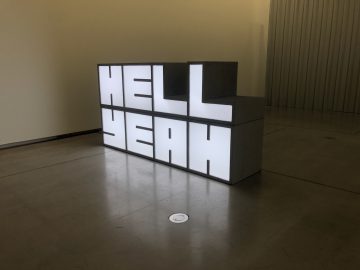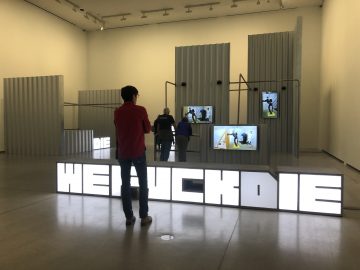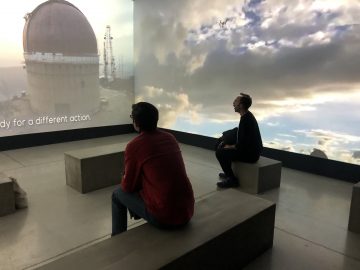What does the world feel or look like through the eyes of a drone camera?
How has technology changed conflict?
Will robots take over the world?
How do we contend with the loss of a friend – who’s likeness becomes the symbol of a revolution?
How does AI interpret the sound of breaking glass?

Hell Yeah We F–K Die by Hito Steyerl (2016). Photo courtesy of author.
These are some questions that were posed to audiences at artist Hito Steyerl’s solo show, currently on until the end of February at the Art Gallery of Ontario (AGO).
Steyerl is well regarded as one of the most influential artists of our time. The AGO describes her practice succinctly in this excerpt from their website:
“Steyerl is a storyteller. Using her signature essayist documentary style – poetic narration supported by a unique blend of pop cultural images, documentary footage and computer-animated sequences – she presents a vision of our world that is at once humorous and frightening.
Her playful explorations of technology and power structures result in darkly ironic cultural critiques that feel particularly relevant today. She blends the personal with the political, the satirical with the serious, while addressing a range of topics from economic collapse to globalization. Steyerl draws us into her world, asking us to reflect on our own roles in shaping the not-so-distant future”.

Gallery installation. Photo courtesy of author.
At first, this show did not seem to strike as something I would normally include for the Digital Tattoo Artists’ Series, but hear me out. A lot of what Steyerl is talking about through her work is inherently about humanity and its relationship to technology going forward – the dangers and the wonders of it.
Take her piece ExtraSpaceCraft, a massive video installation that engulfs the room in its footage. A drone flies through the sky, observing the National Observatory of Iraq – now in disrepair and derelict.
It cleverly gives voice to this drone as it observes the landscape – the drone considers its own life as a drone, its function and its purpose. This anthropomorphized machine gives away to funny scenes of a parallel world featuring “cosmonauts from a fictional space agency [who] inhabit the observatory”.
It really implies a sort of loss of freedom or sense of self upon the oppression of a state. Politically charged, it shows a life not often seen, perspectives not covered by Western media. To give a drone a voice is to give a machine a life, therefore blurring the lines between ourselves and the potential of technology.

Image still from ExtraSpaceCraft (2016) showing the autonomous drone living its life now as an animated sheep. Photo courtesy of author.
This is echoed in the piece Hell Yeah We F— Die, “[combining] the five words that have appeared most frequently in the titles of songs on the English-language music charts over the past decade”. This work includes videos of robot technology testing labs, “in which humanoid robots are subject to abuse, both real and simulated, all supposedly in the name of progress”. These kinds of videos have gained popularity on the Internet over the past few years, with Boston Dynamic posting to YouTube their robotic development. Here again, we see this sort of collusion between humanoid robotic inventions and the advancement of technology.
Leading to satirical YouTube compilations:
The invention of humanoid robots have huge implications for us all. How does technology factor into our everyday lives, and how will it shape us in the future?

Installation view of ExtraSpaceCraft (2016). Photo courtesy of author.
The sentiment of collusion or compliancy with robot life is tackled in the piece, Robots Today, a film that looks at the ongoing conflict at the Turkish-Syrian border. In the video, Stereyl asks the popular iPhone AI Siri a number of questions, including– is artificial intelligence implicated in modern warfare? A heavy question indeed; and a timely one. How do these new technologies as helpful as Siri, but as sinister as drone warfare, create a complicated ongoing relationship with our futures – one that we will have to wait to unfold.
This exhibition made a strong impact on me – Steyerl’s themes were conveyed with playfulness and elegance. She creates an alluring atmosphere to be critical within – drawing together modern tech mixed with whimsical application. It is a real pleasure to walk around in, with many avenues, areas and artworks to interact with.
The most important element of her work, however, is narrative. Steyerl’s strong voice guides the visitor along without confusion or alienation. She shows an honest perspective that is both enchanting and alarming, something which left me thinking about the work for many weeks following my initial visit.
Check out Steyerl’s exhibition at the Art Gallery of Ontario, currently on until February 23, 2020.
https://ago.ca/exhibitions/hito-steyerl-future
Written By: Defne Inceoglu
Edited by: Samantha Summers

